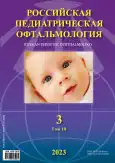Study design and immediate results of combined opto-pharmacological treatment of progressive myopia in children
- Authors: Tarutta E.P.1, Proskurina O.V.1, Tarasova N.A.1, Arutyunyan S.G.1, Markosyan G.A.1, Milash S.V.1
-
Affiliations:
- Helmholtz National Medical Research Center of Eye Diseases
- Issue: Vol 18, No 3 (2023)
- Pages: 155-161
- Section: Original study article
- URL: https://journals.rcsi.science/1993-1859/article/view/163807
- DOI: https://doi.org/10.17816/rpoj516533
- ID: 163807
Cite item
Abstract
Eye drops that affect dynamic refraction and pupil width can enhance the effect of optical treatment by forming relative peripheral myopic defocus on the refractogenesis of children with myopia.
AIM: To evaluate the effect of combined optopharmacological effects on the dynamics of central and peripheral refraction, accommodation, visual function, and choroid thickness in children with progressive myopia.
MATERIAL AND METHODS: The study involved 40 children aged 8–13 years with myopia from 1.75 to 6.37 dptr. These children were given glasses forming peripheral myopic defocus for the first time. Of these, 20 children, after 1 month, were prescribed combined eye drops containing 0.8% tropicamide and 5% phenylephrine.
RESULTS: One month from the start of wearing glasses, the monocular visual acuity with glasses was 0.94±0.02. After the eye drop application, the visual acuity with glasses significantly increased to 1.06±0.02 (p <0.01). This was explained by a significant decrease in the usual tone of open-field accommodation (PTA-OP) to +0.01±0.04. A clinically significant (p <0.05) increase in relative accommodation reserves (ZOA) by 0.71 dptr was revealed, and opto-pharmacological effects were not observed on mesopic contrast sensitivity and peripheral refraction. Choroid thickness increased by 4.7%.
CONCLUSION: During the observation period, accommodation tended to normalize, and the thickness of the choroid increased clinically significantly. Further observations are needed to evaluate the effectiveness of combined optopharmacological treatment in comparison with optical exposure.
Full Text
##article.viewOnOriginalSite##About the authors
Elena P. Tarutta
Helmholtz National Medical Research Center of Eye Diseases
Email: elenatarutta@mail.ru
ORCID iD: 0000-0002-8864-4518
MD, Dr. Sci. (Med.), Рrofessor
Russian Federation, MoscowOlga V. Proskurina
Helmholtz National Medical Research Center of Eye Diseases
Author for correspondence.
Email: proskourina@mail.ru
ORCID iD: 0000-0002-2496-2533
SPIN-code: 1057-5866
MD, Dr. Sci. (Med.)
Russian Federation, MoscowNatalia A. Tarasova
Helmholtz National Medical Research Center of Eye Diseases
Email: tar221@yandex.ru
ORCID iD: 0000-0002-3164-4306
SPIN-code: 3056-4316
MD, Cand. Sci. (Med.)
Russian Federation, MoscowSona G. Arutyunyan
Helmholtz National Medical Research Center of Eye Diseases
Email: arutyunyansg@mail.ru
ORCID iD: 0000-0002-3788-2073
MD, Cand. Sci. (Med.)
Russian Federation, MoscowGajane A. Markosyan
Helmholtz National Medical Research Center of Eye Diseases
Email: dvdomdv@mail.ru
ORCID iD: 0000-0002-2841-6396
MD, Dr. Sci. (Med.)
Russian Federation, MoscowSergey V. Milash
Helmholtz National Medical Research Center of Eye Diseases
Email: sergey_milash@yahoo.com
ORCID iD: 0000-0002-3553-9896
SPIN-code: 5224-4319
MD, Cand. Sci. (Med.)
Russian Federation, MoscowReferences
- Tarutta EP, Proskurina OV, Milash SV, et al. Peripheral defocus induced by «Perifocal-m» spectacles and myopia progression in children. Russian Pediatric Ophthalmology. 2015;10(2):33–37. (In Russ).
- Tarutta EP, Proskurina OV, Tarasova NA, et al. Long-term results of perifocal defocus spectacle lens correction in children with progressive myopia. The Russian Annals of Ophthalmology. 2019;135(5):46–53. (In Russ). doi: 10.17116/oftalma201913505146
- Tarutta EP, Proskurina OV, Tarasova NA, et al. Short-term results of wearing spectacle lenses with embedded rings of highly aspherical lenslets Stellest™ for myopia control. Russian Ophthalmological Journal. 2022;15(4):89–94. (In Russ). doi: 10.21516/2072-0076-2022-15-4-89-94
- Lam CSY, Tang WC, Tse DY, et al. Defocus Incorporated Multiple Segments (DIMS) spectacle lenses slow myopia progression: a 2-year randomised clinical trial. Br J Ophthalmol. 2020;104(36):363–368. doi: 10.1136/bjophthalmol-2018-313739
- Lam CSY, Tang WC, Lee PH, et al. Myopia control effect of defocus incorporated multiple segments (DIMS) spectacle lens in Chinese children: results of a 3-year follow-up study. Br J Ophthalmol. 2022;106(8):1110–1114. doi: 10.1136/bjophthalmol-2020-317664
- Bao J, Yang A, Huang Y, et al. One-year myopia control efficacy of spectacle lenses with aspherical lenslet. Br J Ophthalmol. 2022;106(8):1171–1176. doi: 10.1136/bjophthalmol-2020-318367
- Bao J, Huang Y, Li X, et al. Spectacle lenses with aspherical lenslets for myopia control vs single-vision spectacle lenses a randomized clinical trial. JAMA Ophthalmol. 2022;140(5):472–478. doi: 10.1001/jamaophthalmol.2022.0401
- Proskurina OV, Golubev SYu, Markova EYu. Sub”ektivnye metody issledovaniya akkomodatsii. In: Katargina LA, editor. Akkomodatsiya. Rukovodstvo dlya vrachei. Moscow: Aprel’; 2012. P. 40–49. (In Russ).
- Tarutta EP, Proskurina OV, Tarasova NA, et al. Kachestvo zreniya i adaptatsiya k ochkam s novymi linzami dlya kontrolya miopii Stellest. 14th Russian National Ophthalmological Forum. 2021;1:317–319. (In Russ).
- Proskurina OV, Tarasova NA, Markosyan GA, et al. Аdaptation and quality of vision in glasses with lenses for the control of stellest myopia with built-in high-spherical microlenses. Russian Pediatric Ophthalmology. 2022;17(2):5–12. (In Russ). doi: 10.17816/rpoj97296
- Chen Z, Xue F, Zhou J, et al. Effects of оrthokeratology on сhoroidal thickness and axial length. Optom Vis Sci. 2016;93(9):1064–1071. doi: 10.1097/OPX.0000000000000894
Supplementary files






